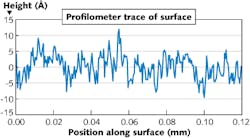Converting raw optical surface profilometer data (describing surface roughness) into a bidirectional-scatter distribution function (BSDF) and a power-spectral-density (PSD) function can be prone to procedural mistakes. Photon Engineering (Tucson, AZ) has developed a photonics software “recipe” that eliminates this uncertainty—a step-by-step numerical process that includes three checkpoints.
The recipe is simple. Start with scanned profilometer data containing N samples of surface height data h0(x) taken at some constant sample distance Δx on an isotropic scattering surface. Next, remove piston, tilt, and curvature of the data using a least-squares minimization and compute root-mean-squared (rms) surface roughness. Compute the 1D PSD over several scans to reduce the statistical noise. Use a closed-form Abel transform to compute a 2D PSD from 1D PSD data. Convert the 2D PSD into a BSDF then fit to a Harvey-Shack form. Compare the rms roughness results at three checkpoints: from the original surface height data; the integrated PSD values; and the integration of the BSDF. Despite the considerable numerical manipulation, the recipe is straightforward and self-checking at multiple stages of the computational process. Contact Rich Pfisterer at [email protected].

